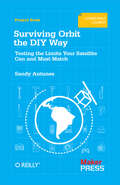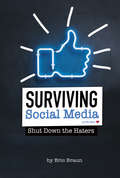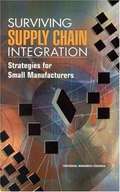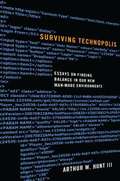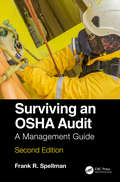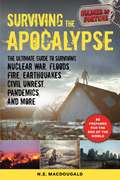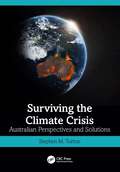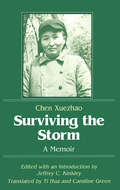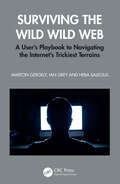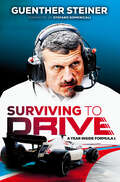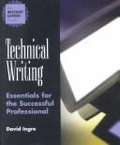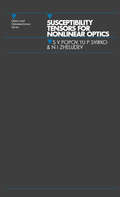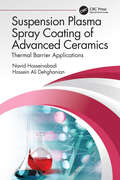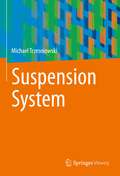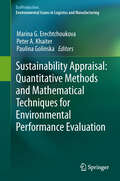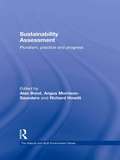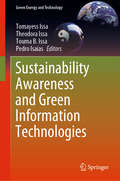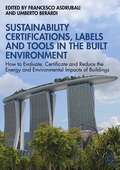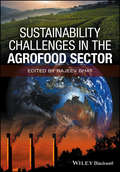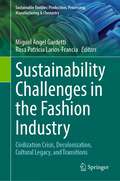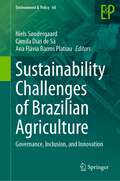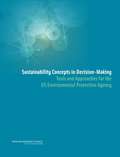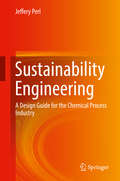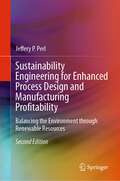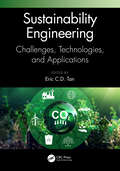- Table View
- List View
Surviving Orbit the DIY Way: Testing the Limits Your Satellite Can and Must Match
by Sandy AntunesIs your picosatellite ready for launch? Can it withstand rocket thrusts and the vacuum of space? This do-it-yourself guide helps you conduct a series of hands-on tests designed to check your satellite’s readiness. Learn precisely what the craft and its electronic components must endure if they’re to function properly in Low Earth Orbit.The perfect follow-up to DIY Satellite Platforms (our primer for designing and building a picosatellite), this book also provides an overview of what space is like and how orbits work, enabling you to set up the launch and orbit support you’ll need.Go deep into the numbers that describe conditions your satellite will faceLearn how to mitigate the risks of radiation in the ionospherePick up enough formal systems engineering to understand what the tests are all aboutBuild a thermal vacuum chamber for mimicking environment of spaceSimulate the rocket launch by building and running a vibration shake testUse a homebuilt centrifuge to conduct high G-force testsGet guidelines on scheduling tests and choosing an appropriate lab or clean room
Surviving Social Media: Shut Down the Haters (Informed!)
by Eric BraunNearly 75 percent of the U.S. population uses social media. For students, it is often considered a lifeline to connecting with their peers and staying relevant. But there's a dark side as well. How much social media use is healthy? What happens when trolls take over? Where do you go for help? Readers will learn to understand the pros and cons of social media and how to make smart decisions about managing their online presence.
Surviving Supply Chain Integration: Strategies for Small Manufacturers
by National Research CouncilThe managed flow of goods and information from raw material to final sale also known as a "supply chain" affects everything--from the U.S. gross domestic product to where you can buy your jeans. The nature of a company's supply chain has a significant effect on its success or failure--as in the success of Dell Computer's make-to-order system and the failure of General Motor's vertical integration during the 1998 United Auto Workers strike.Supply Chain Integration looks at this crucial component of business at a time when product design, manufacture, and delivery are changing radically and globally. This book explores the benefits of continuously improving the relationship between the firm, its suppliers, and its customers to ensure the highest added value.This book identifies the state-of-the-art developments that contribute to the success of vertical tiers of suppliers and relates these developments to the capabilities that small and medium-sized manufacturers must have to be viable participants in this system. Strategies for attaining these capabilities through manufacturing extension centers and other technical assistance providers at the national, state, and local level are suggested.This book identifies action steps for small and medium-sized manufacturers--the "seed corn" of business start-up and development--to improve supply chain management. The book examines supply chain models from consultant firms, universities, manufacturers, and associations. Topics include the roles of suppliers and other supply chain participants, the rise of outsourcing, the importance of information management, the natural tension between buyer and seller, sources of assistance to small and medium-sized firms, and a host of other issues.Supply Chain Integration will be of interest to industry policymakers, economists, researchers, business leaders, and forward-thinking executives.
Surviving Technopolis: Essays on Finding Balance in Our New Man-Made Environments
by Arthur W. Hunt IIIThese essays not only evaluate Technopolis, but also seek wisdom to cope with our new human-made environments. Positively stated, they offer suggestions on how to bring us back into balance. Some of our best wisdom in analyzing Technopolis can be found in the voices of the Christian humanists. Unlike Enlightenment humanism, which tends to be human-centered, Christian humanism is concerned with the role of humankind within God's created order.
Surviving an OSHA Audit: A Management Guide
by Frank R. SpellmanHailed on its first publication as a masterly account detailing a roadmap for compliance with workplace standards, regulations, and rules, Surviving an OSHA Audit: A Management Guide, Second Edition, is specifically designed for managers and other professionals who seek to provide a safe work environment. It also serves as a helpful reference for those who want to keep OSHA from repeatedly knocking on the door and issuing citations that can be both embarrassing and expensive. Completely revised and updated with eight important chapters added, emphasis is placed on compliance through vigilance and proper work practices. With compliance in mind, it is important to recognize that OSHA regulations, standards, or rulings are not static; they continue to be revised over time. This new edition highlights those areas of regulation that have changed as well as those that are still current and relevant. Features: Fully updated to reflect the most up-to-date changes in regulation. Presents numerous practical examples throughout. Examines the importance of and best practices for recordkeeping protocols. This book is an excellent resource and guide relevant to a broad audience, including academia, legal professionals, workplace managers, safety professionals, students, and administrators at all levels.
Surviving the Apocalypse: The Ultimate Guide to Surviving Nuclear War, Floods, Fire, Earthquakes, Civil Unrest, Pandemics, and More (Soldier Of Fortune Ser.)
by N. E. MacDougaldThe Apocalypse could arrive at any moment, but with Surviving the Apocalypse, you'll be well-prepared and well-trained enough to survive any disaster—even the end of the world as we know it. Being prepared for what&’s out there is important—you have to know what to do when everything falls apart. Knowing how to survive the end of the world as we know it will prepare you for anything and everything that could possibly go wrong. From packing the proper survival kit, to surviving on the battlefield, being physically fit, and coping in the event of a socio-economic collapse, Soldier of Fortune magazine, along with N. E. MacDougald, will make sure that you&’re never caught off-guard in any situation, from natural and economic disasters to pandemics and civil unrest—even nuclear war. The purpose of this book is to provide the reader with real-world, practical information that will help them to not only survive, but thrive during a period that is likely not just another downturn in the economic cycle, but according the many experts, instead the beginning of a long downward slide, and possibly the very peak in our 10,000-year experiment of civilization. While you may not plan on being in a war zone, you never know what will happen, so the best thing to always do is be prepared. Whether it's learning how to barter and haggle, how to get the proper camouflage, or how to choose the right weapon for any situation, MacDougald and Surviving the Apocalypse will give you the training and knowledge that goes into surviving any and every dangerous situation imaginable.
Surviving the Climate Crisis: Australian Perspectives and Solutions
by Stephen M. TurtonThis is the first textbook to adopt an integrated perspective of climate change in Australia, drawing on research from the latest Intergovernmental Panel on Climate Change (2021, 2022) Sixth Assessment Reports to make it the most up-to-date resource available. It fills a knowledge gap in an ever-increasing hot topic for the country, its people, economy and environment. Australia has been identified by a number of respected sources as a ‘climate change hotspot’, with all major sectors of the economy considered vulnerable or highly vulnerable to the anticipated adverse impacts of climate change. The chief industry sectors examined in this book include energy, transportation, manufacturing, agriculture, fisheries, forestry, tourism and mining. Other chapters focus on other key thematic areas, such as protected areas and world heritage sites (including their natural and cultural values), coastal and island environments, biosecurity, biodiversity and ecosystem services, human health, water resources, cities and settlements, rural and regional areas, and Indigenous communities. Ideal for advanced undergraduate and graduate students with limited science backgrounds, this book will inform those undertaking business, management, sustainability, education, environmental, development or heritage studies and other social science programs.
Surviving the Storm: A Memoir
by Chen XuezhaoMemoirs of the Chinese author, Chen Xeuzhao, who was branded a rightist by the communist authorities. The book tells of her suffering during the Cultural Revolution.
Surviving the Wild Wild Web: A User’s Playbook to Navigating the Internet's Trickiest Terrains
by Marton Gergely Ian Grey Heba SaleousThe information security arena is often vague and confusing for internet users, both young and old. New traps are being devised daily, and falling into them can take legal, ethical, financial, physical, and mental tolls on individuals. With increasing cases of fake news, identity theft, piracy, spying, and scams surfacing, this book explains the risks of the internet and how they can be mitigated from a personal and professional perspective.Surviving the Wild Wild Web: A User’s Playbook to Navigating the Internet’s Trickiest Terrains is a readable guide addressing the malicious behaviors within internet cultures. Written in simple and jargon-free language, the book describes ten pillars of information security risks faced by all internet users. Each pillar will be detailed as a story, starting with the roots of the problem and branching out into tangential related issues and topics. Each chapter ends by detailing ways a user can avoid falling victim to cyber threats. It uses a combination of news articles, topical current events, and previously published academic research to underpin the ideas and navigates how users interact with the World Wide Web. The book aims to create a generation of internet-literate readers who can spot the pitfalls of the internet in their personal and professional lives to surf the web safely.This guide will appeal to any individual interested in internet safety, with a potential readership extending to students and professionals in the fields of computer science, information systems, cybersecurity, business, management, human resources, psychology, medicine, education, law, and policy.
Surviving to Drive: A Year Inside Formula 1: An F1 Book
by Guenther Steiner#1 SUNDAY TIMES BESTSELLER • A high-octane, no-holds-barred account of a year inside Formula 1 from Haas team principal Guenther Steiner, star of Drive to Survive, one of the most successful Netflix series of all time&“People talk about football managers being under pressure. Trust me, that's nothing. Pressure is watching one of your drivers hit a barrier at 190mph and exploding before your eyes...&”In Surviving to Drive, Haas team principal Guenther Steiner brings readers inside his Formula 1 team for the entirety of the 2022 season, giving an unobstructed view of what really takes place behind the scenes. Through this unique lens, Steiner guides readers on the thrilling rollercoaster of life at the heart of high-stakes motor racing. Packed full of twists and turns, from pre-season preparations to hiring and firing drivers, from the design, launch, and testing of a car to the race calendar itself–Surviving to Drive is the first time that an Formula 1 team has allowed an acting team principal to tell the full story of a whole season.Uncompromising and searingly honest, told in Steiner's inimitable style, Surviving to Drive is a fascinating and hugely entertaining account of the realities of running a Formula 1 team.
Survivor's Guide to Technical Writing
by David IngreThis book presents the essentials of communication based on a unique and dynamic model that integrates context, message, audience, purpose, and product (CMAPP).
Susceptibility Tensors for Nonlinear Optics (Series In Optics And Optoelectronics Ser.)
by S.V PopovSusceptibility Tensors for Nonlinear Optics is a unique and invaluable reference book with accompanying software. Starting from basic principles, the book presents a detailed introduction to the concept of optical susceptibilities of crystalline media. Substantial appendices include useful tables of third-, fourth-, and fifth-rank susceptibility tensors for major nonlinear optical effects. Integral to the book is an entirely original TURBO RANK software package (compatible with PCs running MS-DOS and Windows) that allows the calculation of the symmetry of material tensors up to seventh rank, effectively superseding conventional reference tables of high rank tensors. This package is also useful for scientists working in solid state physics, crystallography, acoustics, and materials engineering.
Suspension Plasma Spray Coating of Advanced Ceramics: Thermal Barrier Applications
by Navid Hosseinabadi Hossein Ali DehghanianSuspension Plasma Spray Coating of Advanced Ceramics presents the significance of suspension plasma spray coating of ceramics for thermal barrier applications. It covers suspension formation and optimization in different oxide and non-oxide mixtures and ceramic matrix composites (CMC) of sub-micron and nanosized powders. Enabling readers to understand the importance of thermally inert and insulating ceramic coatings on metals and alloys, the book explains how to improve their utilization in applications, such as turbine blades or diesel engines, gas turbines, and coating methods. This book also discusses advanced topics on nanomaterials coatings in monolithic or composite forms as thermal barriers through organic and non-organic based suspensions using high energy plasma spray methods. Features: Presents significant thermal barrier properties using high energy plasma spray methods. Explores advanced surface modification techniques. Covers monolithic, composite, and solid solution ceramics coating. Discusses high precision coating methods. The book will be useful for professional engineers working in surface modification and researchers studying materials science and engineering, corrosion, and abrasion.
Suspension System
by Michael TrzesniowskiIn this book, the reader learns the essential differences to the passenger car through the analysis divided according to assemblies. This gives him the tools to apply the detailed knowledge he has acquired to the design and development of competition vehicles. The chassis determines the driving behaviour and thus the "DNA" of a racing vehicle like no other assembly. Starting with the tyre - the decisive mechanical component - all the components of the wheel suspension including steering and braking system are presented and discussed. The focus is on the double wishbone and suspension strut axles. The design of wheel suspensions starts with kinematic considerations, leads via component design to considerations of the vehicle dynamics. Ultimately, the maximum forces of the tires in the transverse and circumferential directions are to be exploited while keeping the vehicle controllable. Due to the detailed, in-depth presentation, the work is just as suitable for the interested motorsport enthusiast as it is for the engineer in practice who is dealing with questions relating to racing suspensions. The formula material is prepared in such a way that the book can also be used as a reference work.
Sustainability Appraisal: Quantitative Methods and Mathematical Techniques for Environmental Performance Evaluation
by Paulina Golinska Marina G Erechtchoukova Peter A KhaiterOne of the most important issues in developing sustainable management strategies and incorporating ecodesigns in production, manufacturing and operations management is the assessment of the sustainability of business operations and organizations' overall environmental performance. The book presents the results of recent studies on sustainability assessment. It provides a solid reference for researchers in academia and industrial practitioners on the state-of-the-art in sustainability appraisal including the development and application of sustainability indices, quantitative methods, models and frameworks for the evaluation of current and future welfare outcomes, recommendations on data collection and processing for the evaluation of organizations' environmental performance, and eco-efficiency approaches leading to business process re-engineering.
Sustainability Assessment: Pluralism, practice and progress (Natural and Built Environment Series)
by Alan Bond Angus Morrison-Saunders Richard HowittSustainability Assessment is an increasingly important tool for informing planning and development decisions across the globe. Required by law in some countries, strongly recommended in others, a comprehensive analysis of why Sustainability Assessment is needed and clarification of the value-laden and political nature of assessments is long overdue. Currently the writing on the subject is limited and comprises, for the most part, guidance documents and completed assessments. This book overcomes these shortcomings by simultaneously providing the knowledge, inspiration and range of assessment tools in decision-making students require to tackle Sustainability Assessment challenges nested within wide-ranging values and sustainability-grounded evidence. The collection details the current state-of-the art in relation to Sustainability Assessment theory and practice, and considers the pluralistic nature of the tool and the implications for achieving sustainable decision-making. The contributors set out the context for Sustainability Assessment and then outline some contested issues which can affect interpretations of whether the decision tool has been effective. Current practice worldwide is assessed against a consistent framework and then solutions to some of the inherent weaknesses and causes of conflict in relation to the perceived sustainability of outcomes are put forward. The book is unique in setting out state-of-the-art in terms of Sustainability Assessment practice by focusing on those countries with developing experience. It also covers emerging factors influencing effectiveness of decision-making tools and evaluates how they affect the performance of Sustainability Assessment. Written by authors among the leading university academics teaching impact assessment courses in the most acclaimed universities worldwide operating in this field, it is ideally suited for the growing numbers of courses in impact assessment education and training.
Sustainability Awareness and Green Information Technologies (Green Energy and Technology)
by Pedro Isaias Tomayess Issa Theodora Issa Touma B. IssaThis book addresses several aspects of environmental sustainability awareness and priorization, explores ways to use resources and processes more responsibly, and describes the strategies, models and tools required to overcome various challenges. Sustainable and green IT are used to minimize the current ICT recycling problems which are harming our planet. The book discusses the new green information technologies as alternatives to conventional ICT, which have significantly harmed nature, and examines how to make recent technologies such as cloud computing; social networking; smart technology; blockchains, IoT (internet-of-things); and big data sustainable. Exploring sustainability awareness and importance among individuals and organizations in the developed and developing countries, most of the contributions conclude that sustainability should be considered a duty in order to change mindsets, attitudes and actions so as to preserve our planet. Furthermore, it examines the green information technology strategies and models.
Sustainability Certifications, Labels and Tools in the Built Environment: How to Evaluate, Certificate and Reduce the Energy and Environmental Impacts of Buildings
by Umberto Berardi Francesco AsdrubaliThis book is aimed at covering all aspects of the evaluation, certification, and reduction of the energy and carbon footprint of the built environment from the scale of the city and its neighbourhoods, to the building level and finally to the level of single building materials and components. Many protocols, tools, and labels have been proposed in recent years, both at international and local levels, and the aim of the book is to classify, describe, and discuss all the different approaches and options.The chapters offer a comprehensive, up-to-date, and critical review of all the different certification methods that have been proposed at different levels in the building sector. The first chapter introduces the topic and its importance, providing data on the impact of the building sector and the construction industry. The following chapters are dedicated respectively to tools and protocols for cities and neighbourhood sustainability assessment, tools and protocols for buildings sustainability assessment and certification, and for building materials and components. Finally, this book includes an overview of the legislation and standards in the field and case studies to exemplify the application of the different tools and labels.This is a key reference for decision-makers, researchers, scholars, students, and professionals approaching research and work in the field of energy and environmental impact of the building sector be they engineers, architects, planners, owners, developers, or facility managers.
Sustainability Challenges in the Agrofood Sector
by Rajeev BhatSustainability Challenges in the Agrofood Sector covers a wide range of agrofood-related concerns, including urban and rural agriculture and livelihoods, water-energy management, food and environmental policies, diet and human health. Significant and relevant research topics highlighting the most recent updates will be covered, with contributions from leading experts currently based in academia, government bodies and NGOs (see list of contributors below). Chapters will address the realities of sustainable agrofood, the issues and challenges at stake, and will propose and discuss novel approaches to these issues. This book will be the most up-to-date and complete work yet published on the topic, with new and hot topics covered as well as the core aspects and challenges of agrofood sustainability.
Sustainability Challenges in the Fashion Industry: Civilization Crisis, Decolonization, Cultural Legacy, and Transitions (Sustainable Textiles: Production, Processing, Manufacturing & Chemistry)
by Miguel Ángel Gardetti Rosa Patricia Larios-FranciaFashion, and the growth of fashion, are presented as the manifestation of a process of civilization, within a capitalist culture (capital understood as material possessions) that has become global and imperialist, of which - in an economic sense - the industry (or the fashion system?) functions as one of its main instruments of exploitation. And with respect to design, Arturo Escobar said: "Can design detach itself from its roots in modernist practices of unsustainability and defuturization and reorient itself towards other commitments, practices, narratives and ontological enactions? Moreover, can design be part of the toolkit for the transition to the pluriverze (i.e. a world in which many worlds can fit)?" This book presents the importance of cultural sustainability in the textiles and fashion industry, decolonizing fashion system and promotes the design for transitions.
Sustainability Challenges of Brazilian Agriculture: Governance, Inclusion, and Innovation (Environment & Policy #64)
by Niels Søndergaard Camila Dias de Sá Ana Flávia Barros PlatiauWith contributions from a wide range of thematic areas, this book provides a diverse perspective on the contemporary environmental challenges of Brazilian agriculture. Assessing existing experiences of governance interventions, implementation of inclusive and sustainable production practices, as well as technical innovations, this edited volume presents the reader with a nuanced perspective on sustainable future pathways for Brazilian agriculture. In many cases, actors within the agricultural sector stand in a key position to address environmental concerns, which often has generated important breakthroughs and improvement of production practices. Drawing on contributions from authors within a variety of fields, this contribution presents a trans-disciplinary perspective on the problems and pathways through which multi-level interventions can lead to sustainable solutions within the Brazilian agricultural and livestock sector. This book hereby constitutes an informed and timely contribution to the important debates about Brazil’s potential role in confronting environmental problems. More broadly, this volume also sheds light on the process of agricultural transitions in the Global South, and how food security concerns may be reconciled with sustainable production.
Sustainability Concepts in Decision-Making: Tools and Approaches for the US Environmental Protection Agency
by Committee on Scientific Tools Approaches For SustainabilityIn its current strategic plan, the U. S. Environmental Protection Agency (EPA) describes a cross-agency strategy to advance sustainable environmental outcomes and optimize economic and social outcomes through Agency decisions and actions. Sustainability has evolved from an aspiration to a growing body of practices. The evolution includes a transition from the development of broad goals toward the implementation of specific policies and programs for achieving them and the use of indicators and metrics for measuring progress. Without losing focus on implementing its existing regulatory mandates, EPA's incorporation of sustainability considerations into its decision-making about potential environmental, social, and economic outcomes involves shifting from a focus on specific pollutants in an environmental medium (air, water, or land) to a broader assessment of interactions among human, natural, and manufactured systems. EPA has indicated that it will need to consider the use of a variety of analytic tools and approaches to assess the potential sustainability-related effects of its decisions and actions in response to complex environmental challenges. Sustainability Concepts in Decision-Making: Tools and Approaches for the U. S. Environmental Protection Agency examines scientific tools and approaches for incorporating sustainability concepts into assessments used to support EPA decision making. Using specific case studies, this report considers the application of analytic and scientific tools, methods, and approaches presented in the 2011 NRC report Sustainability and the U. S. EPA. This report examines both currently available and emerging tools, methods, and approaches to find those most appropriate for assessing and/or evaluating potential economic, social and environmental outcomes within an EPA decision context. Sustainability Concepts in Decision Making also discusses data needs and post-decision evaluation of outcomes on dimensions of sustainability. A broad array of sustainability tools and approaches are suitable for assessing potential environmental, social, and economic outcomes in EPA's decision-making context. The recommendations of this report will assist the agency to optimize environmental, social, and economic outcomes in EPA decisions.
Sustainability Engineering
by Jeffery PerlThis book explores sustainability engineering through the lens of the manufacturing and chemical process industries to elucidate the safe and economic implementation of process designs used to transform raw materials into useful finished products. The author applies the tenets of sustainability science to develop an engineering methodology that supports the perpetual availability of raw materials through recycling/reuse/repurposing, incorporates inexhaustible supplies, such as solar energy and municipal waste, and encompasses the husbandry of these resources in a manner that minimizes negative environmental impacts. Anyone involved in the design or manufacture of chemicals, or the upgrade of existing manufacturing processes, will benefit from this book's suggestions for identifying improvement options, while adding the pivotal aspect of sustainability to the usual cost and safety equation optimization elements.
Sustainability Engineering for Enhanced Process Design and Manufacturing Profitability: Balancing the Environment through Renewable Resources
by Jeffery P. PerlNow in an expanded and revised second edition, this book explores sustainability engineering through the lens of the manufacturing and chemical process industries to explain the safe and economical implementation of process designs to transform raw materials into valuable finished products. The author applies the principles of sustainability science to engineering methodology for residential, commercial, and industrial applications that support the perpetual availability of raw materials through recycling, reuse, and repurposing to incorporate inexhaustible supplies and encompasses the management and conservation of these resources in a manner that minimizes negative environmental impacts. New sections include:Coverage of electric power opportunities and challenges (solar, wind, and cogeneration),Efficiency improvement as an energy supply extender, Recycling as a material extender. The book examines relevant energy policies driving and affecting commercial, industrial, and residential energy utilization and includes new industrial case studies. Anyone involved in the design or manufacture of chemicals or the upgrade of existing manufacturing processes will benefit from this book’s suggestions for identifying improvement options while adding the pivotal aspect of sustainability to the usual cost and safety equation optimization elements.
Sustainability Engineering: Challenges, Technologies, and Applications
by Tan, Eric C.D.Sustainability Engineering: Challenges, Technologies, and Applications focuses on emerging topics within sustainability science and engineering, including the circular economy, advanced recycling technologies, decarbonization, renewable energy, and waste valorization. Readers will learn the trends driving today’s sustainability research and innovation as well as the latest in sustainable process technologies. This book: Addresses emerging sustainability development challenges, progress, and disruptive technologies Discusses biological sustainability, recycling technologies, and sustainable process design and manufacture Features a comprehensive view from renowned experts who are leaders in their respective research areas This work is aimed at an interdisciplinary audience of engineers and scientists working on solutions to advance the development and application of sustainable technologies, including – but not limited to – chemical and environmental engineers.
